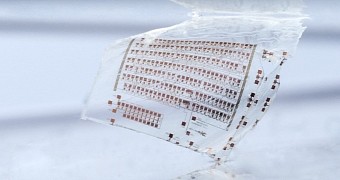A team of Belgian researchers specializing in nanotechnology were able to use inkjet printing technology to create a transistor logic board with almost 3,400 circuits on a surface of just 2 x 2 cm / 0.78 x 0.78 inches.
Normally, it takes some really nifty fabrication techniques to turn a virtual blueprint into a real, physical piece of hardware. It also relies on special materials, usually not in the forms of inks.
However, inkjet printing technology has proven to be quite useful in making thin electronic boards, even flexible or rollable ones.
All of those are just prototypes for now, but they have given us something to look forward to in the years to come.
Now, inkjet printing, that technology normally used to write or draw things on paper, has struck again, evolving into the 3D variety no less.
“Exponential technology” can drive the Internet of things
“Exponential technology” is the term that researchers at Belgian nanotechnology research center IMEC chose to employ for the breakthrough represented by their new transistor logic board.
Dr. Janusz Bryzek is one of the main supporters of the new invention. He is the one who founded the Trillion Sensor movement and has co-founded nine separate companies dedicated to MEMS technologies.
MEMS is short for Micro-Electro-Mechanical Systems, in case you were wondering. Miniaturized mechanical and electro-mechanical elements.
Since someday 3D printers will be capable of printing transistors with the power of today's conventional chips, the path to that stage has to start somewhere.
The new breakthrough from imec might be that starting point and will definitely allow the Internet of Things to establish itself quickly. A type of lifestyle wherein all appliances and devices in a home are interlinks and, in turn, connected to a cloud server or another via the Internet.
Internet of Things allows you to control anything and everything in your house from any point in said house, or even when away from home via a phone or PC app.
Since IoT is supposed to become reality, at least among the rich, by 2020, starting perhaps as early as 2016, companies should adopt 3D printing technology as soon as possible, Bryzek feels.
The 3D printed circuit board
While details on the technology aren't all that abundant, we do know that transistor board with its 3,400 circuits runs at 6 Hz.
It might sound like very little, until you realize that conventional, silicon CPUs based on nanotechnology have billions upon billions of transistors and provide only 500 – 600 times more than that performance.
Between this breakthrough and all other micro- or nanoprinting technologies being developed, we have a lot of great things to look forward to.

 14 DAY TRIAL //
14 DAY TRIAL //